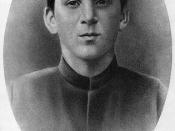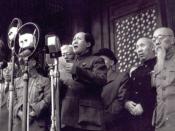During the rise of Communism one of the most difficult tasks that a leader had to face was to have the citizens of the country to agree with and support the idea of communism. This would, without doubt, not be an easy task because never does an entire country believe the same thing. But all believing the same thing and working together is one of the main characteristics of communism itself. Two countries tried to morph their society to fit the standards of Marxist communism, everyone working together for the same common goal with no personal gain desired. Mao Tse Tung in China and Josef Stalin in Russia were two leaders who tried to change their society very quickly to fit communism but one did better than the other.
Josef Stalin's collectivization began in 1929. Although it was a bloody time for peasant with up to 10 million deaths, Stalin found that he could eliminate the more wealthy kulaks and move all other peasants to collectives.
Collectives were massive farms that were controlled by the government appointed party members. These farms took the land, livestock and farm tools from the peasants driven out by the Red army. This cost the country many lives and much money but Stalin believe it was a necessary prerequisite to his industrial dream. The peasants on these collective farms were eventually put to work building and working in new industrial factories. In 11 years Russia's industrial production went up by 400%.This rapid switch to industrialization did have some detrimental effects on the people of Russia, prices on common good rose to be much higher than afforded and food was even rationed at one point because of how little was being produced from collectivization. Stalin ended his Five-Year Plan with the closing out of any...


